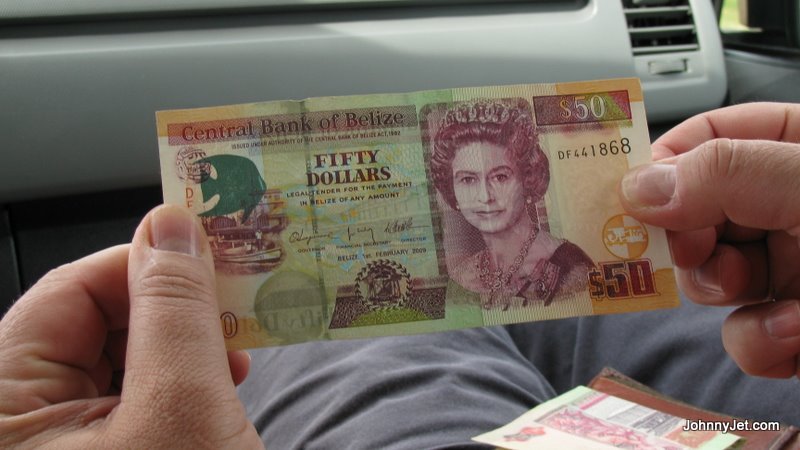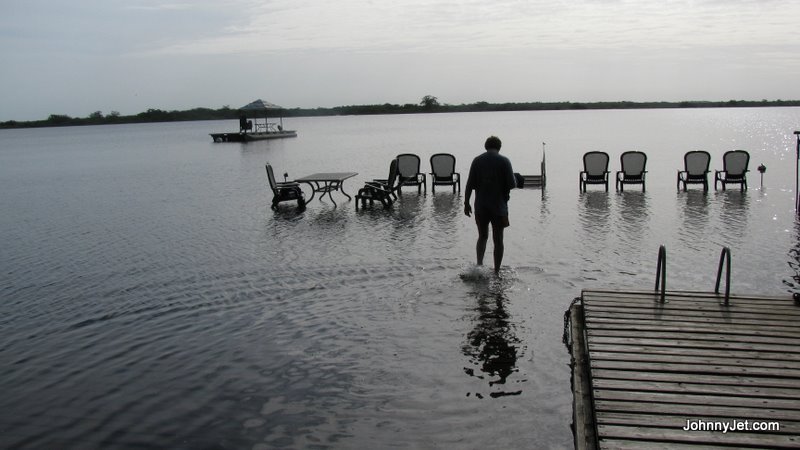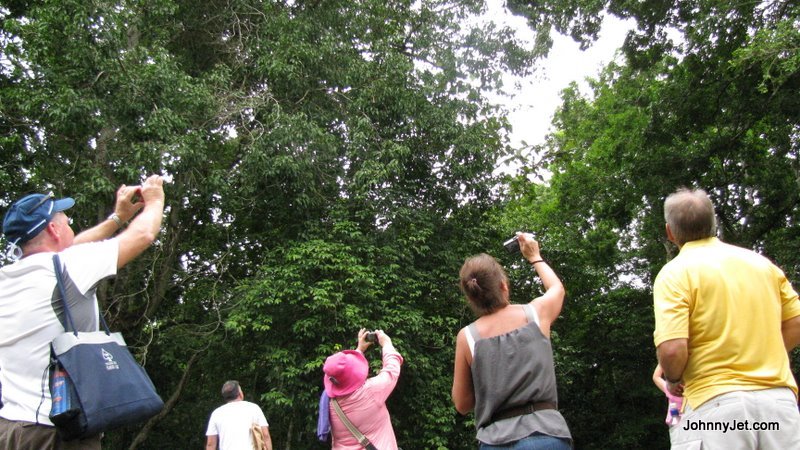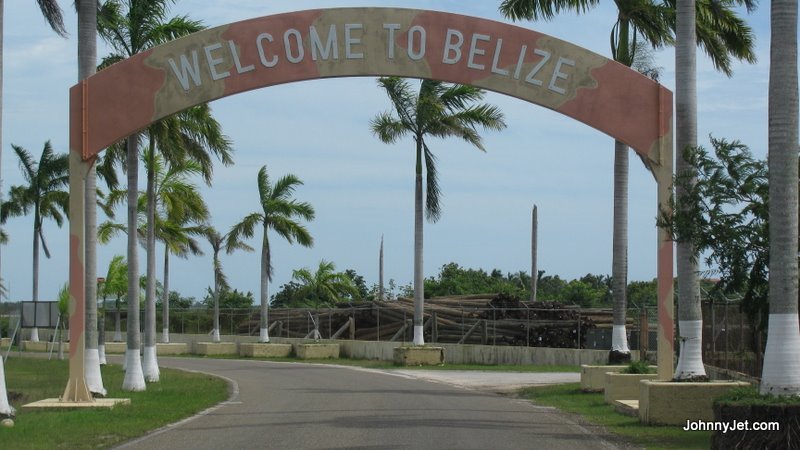
Belize is located just south of Mexico and east of Guatemala at the base of the Yucatan Peninsula in Central America. The country is only 8,805 square miles; roughly the same size as the state of New Hampshire (8,968 square miles) and has a total population of 311,000. You would think that Spanish is the official language but it’s not; English is. That’s because Belize was made a British colony in 1862 (called British Honduras) but achieved its independence in 1981.
DID YOU KNOW? The capital of Belize is Belmopan. The capital used to be Belize City, which is on the coastline but after the devastation of Hurricane Hattie in 1961 they moved it inland. Can you blame them?
The Wild
When people think of Belize, they often think of tropical beaches and the country’s famous Blue Hole and coral reef — the second largest in the world after The Great Barrier. At least, that’s what I associated Belize with. But more than 65% of the country is forested and my Frommer’s Guide taught me that the region was once at the heart of the Maya empire. Archaeologists estimate that one to two million indigenous people lived in this area. Today, Belize is home to 178 plant species, 247 different marine flora, over 550 species of birds and who knows how many animals. Here, you’ll find five different kinds of wild cats; the jaguarondi, puma, margay, ocelot and the jaguar. Did you know that Belize has the highest concentration of jaguars than anywhere else in the world? There are also howler monkeys, green iguanas, boa constrictors and the list goes on and on. And just in case you’re curious, the national animal is the tapir. The best part of Belize is that more than half of its land and marine areas have been set aside as national parks, nature preserves and wildlife sanctuaries. That’s why some call Belize nature’s best kept secret.
Belize Money & Weather
The official currency is the Belizean Dollar (at the time of publication, $1 BZD = $0.47 USD so it’s more than 2:1), but practically everywhere accepts U.S. greenbacks. However, most places will give change in the local currency. The majority of people who come to Belize, come to escape winter as the temperature in Belize pretty much stay the same. Highs hover around 86 degrees F (30 degrees C) and the temperature inland is often five to 10 degrees warmer than on the coast. Last week they had a cold front and the temperature ranged from 72-80 and they considered it “cool”. One of the lodges I stayed at even posted a Freudian slip, describing the weather as “fail and cool.”
The dry season, which runs from January to May, is the best time to come and it’s also the most expensive. The wet season is mid-June until the end of November but it isn’t so wet that you can’t do anything except in the south. Although Belize is in the Hurricane Belt (hurricane season runs the same as the wet season), on average they are hit by a major hurricane once every 20 years. Here’s a link to the 10-day forecast for Belize City.
Airport To Lodge
We landed from Houston, which took just two and a half hours. I was traveling with a production crew as we are filming a TV show and we breezed through the passport control and customs line and jumped on the Lamanai Outpost Lodge van; they were hosting us for the first two nights. It was a 50-minute ride to the lodge’s boat launch and from there it was a 36-mile, 75-minute cruise up the New River. FYI: You can drive to the lodge but that trip takes twice as long and you wouldn’t want to miss out on this boat ride.
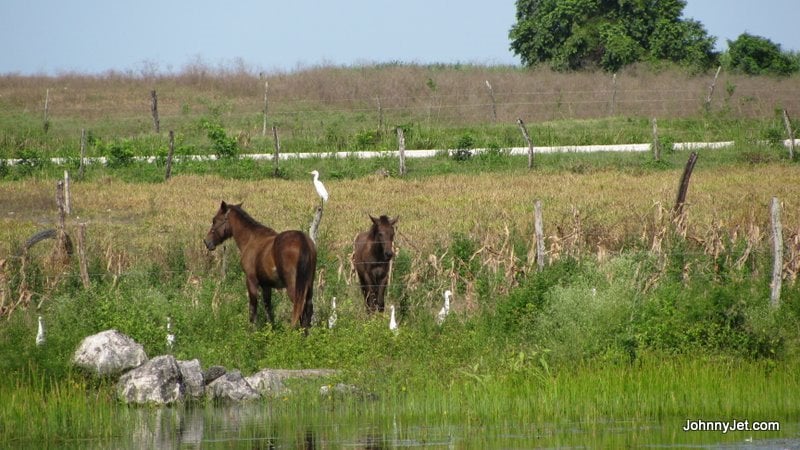
New River
The boats go about 40mph and it’s so smooth I doubt anyone has ever gotten seasick. The water is like glass and looking at the reflection of the surrounding trees is truly special. We also spotted all sorts of birds and bats. The one boat we passed was carrying a few of the 10,000 conservative Prussian Mennonites living in Belize. I had forgotten that there are a few large communities living here. On the return trip, we got a good look at one of their villages. By the way, the boats are not covered so if it’s raining you are going to get wet. However, they do have a tarp to protect the luggage.
We departed for the lodge around 5pm so the last quarter of our trip was in total darkness. Our driver and guide, Ruben, said he could turn the lights on but it would attract bugs. We didn’t care; we just didn’t want to crash and be dinner for the crocs. After all, the word Lamanai means “submerged crocodile” in the Maya language and there are supposedly around 800 living in the area. Besides, on our crocodile excursion offered by the lodge (I will get to that in a minute) we spotted one large croc on both trips to and from the lodge. What’s crazy is that we saw locals, Mennonites and a few lodge workers and guests swimming in the river. Supposedly the crocs don’t bother humans but I’m not that brave.
Lamanai Outpost Lodge
The Lamanai Outpost Lodge is out in the middle of nowhere. It’s technically in Belize’s Orange Walk District, about an hour from the Mexican border (here’s a map). I believe the next closest lodge is 26 miles away and it was built 20 years ago by an Australian who spotted it from the air and fell in love with the area. The workers come from the village that is just a few minutes from the lodge.
Lamanai Outpost Lodge Bungalows
The Outpost Lodge has 17 rooms and ninety percent of the clientele are American. They do get some Canadians and English and I met a family of four vacationing from London. Since it’s so small, it’s easy to make friends and the rest were couples either on their honeymoon or celebrating an anniversary. They all raved about the lodge and said they would definitely come back and recommend it to their friends. My only complaint is that the satellite internet is slow and only works in the dining room and lobby area and the bungalows nearby. I was in bungalow 11, which is close to the water so I didn’t get a signal but my cell phone (T-Mobile Blackberry) worked just fine.
For the record, I’m not fond of having bugs in my room so walking through the dark, low fauna I was skeptical about this place and thought it was going to be a really long two days but I’m happy to report there weren’t many bugs at all in my room. Actually, there were just a few moths and they were only in there because I left the door open for a minute. TIP: Keep your door shut and if you do have bugs, leave the bathroom light on to keep them away from you at night.
Good to know: There’s no TV, radio, clock, telephone, or air conditioning in the rooms. The only thing they have are comfortable beds, a desk, a few lights, umbrella, safe (you don’t need it), flashlight and a ceiling fan, which kept me comfortable. The bathroom has eco-friendly products and plenty of hot water.
Food and Cost
A three-night package at the lodge costs $881 (USD) or $293 per person per night. But keep in mind it includes all meals and taxes, transfers to and from the Belize International Airport and six standard adventure activities, all of which happen just minutes from your cabana. Staff tips are at your discretion but I recommend you do tip since they are so cool.
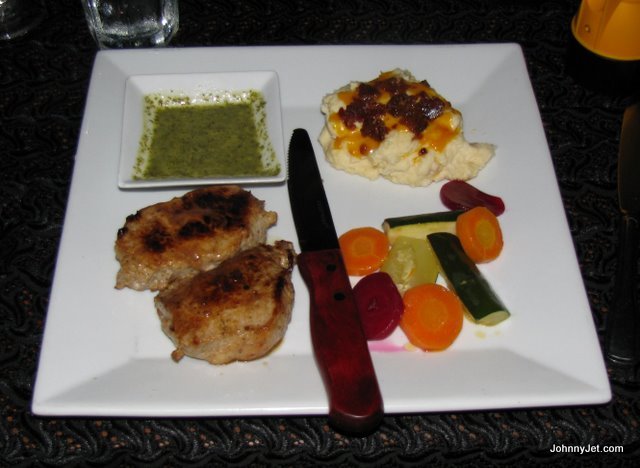 Belizean Food
Belizean Food
The lodge serves fantastic Belizean food, which I wasn’t expecting. There’s no menu, the waitress just tells you what’s for breakfast/lunch and dinner and then asks if it’s okay. Since I’m not a fish kind of guy (they normally serve grouper or snapper) they served me chicken instead.
When we arrived it was dinnertime and the waitress offered us our free welcome drink (anything from the bar). Then came lobster for an appetizer and for the main was a hungry man size portion of pork loin with mashed potatoes that had cheese and bacon on top. It was ridiculously good and so was the cold key lime pie for dessert. Yum!
Breakfast always starts with a bowl of fruit, strong coffee and juice (orange and grapefruit the days I was there). The first morning we had Spanish eggs and the second, spinach frittata. For lunch we had chirmole (ingredients), a hearty soup, followed by carrot cake.
As you can see, Belizean food is made up of lots of rice and beans. Inland, chicken is a popular choice and seafood on the coast. The cuisine is a mishmash of Mexican, Caribbean, African and Spanish cuisines but everything can be found in the cities, including hamburger, pizza and Chinese food joints. Speaking of the Chinese, they own practically every grocery store in Belize.
Note: I love fruit and Belize grows lots of tropical ones. The most common are mangoes, papayas, pineapples, bananas and star fruit.
Lamanai Ruins
My favorite part of the lodge is how close it is to the Maya ruins. In fact, it’s the only Belize lodge situated within walking distance of major Maya ruins. It’s also pretty darn nice to be at the base of a Maya temple or canoeing on the lagoon edge at sunrise with nobody but the monkeys and toucans around. The Lamanai ruins are set in tropical forest and there are hundreds that have yet to be excavated. So far the three most impressive temples are: the Jaguar Temple, the Mask Temple, and the High Temple. I climbed the Jaguar and the High temple and the latter was much more difficult. I have a fear of heights so coming down the High Temple was more nerve racking than holding a wild tarantula that Ruben found under a rock. But the panoramic views from the top are incredible.
Next to the Jaguar Temple is believed to be one of the famous Maya calendars that ends abruptly on December 21, 2012. Hollywood has depicted this date to be the end of the world but in Central America, people are celebrating it as a new beginning. It will be just like the Y2K.
What I love about Belize is that on most days you can have the ruins practically all to yourself. But when a cruise ship comes in (I think they get two a week and I know for sure that one of those days is Thursday), just avoid the middle of the day (between 10am -2pm) since that’s when they take over the place.
Tarantulas
Our guide, Ruben, who grew up in the jungle, went hunting under rocks for tarantulas. Unfortunately when he found one, I had to show him that this city boy wasn’t a wimp like he thought and although I was smiling, I was really screaming on the inside. I did draw the line when he went looking for a snake.
Howler Monkeys
Speaking of wild things, while we were filming we heard what sounded like an angry King Kong. I looked at Ruben and he told me not to worry, explaining that they are just harmless howler monkeys. I heard them again at night (at both lodges) and if I didn’t know what they were I seriously would have FREAKED!
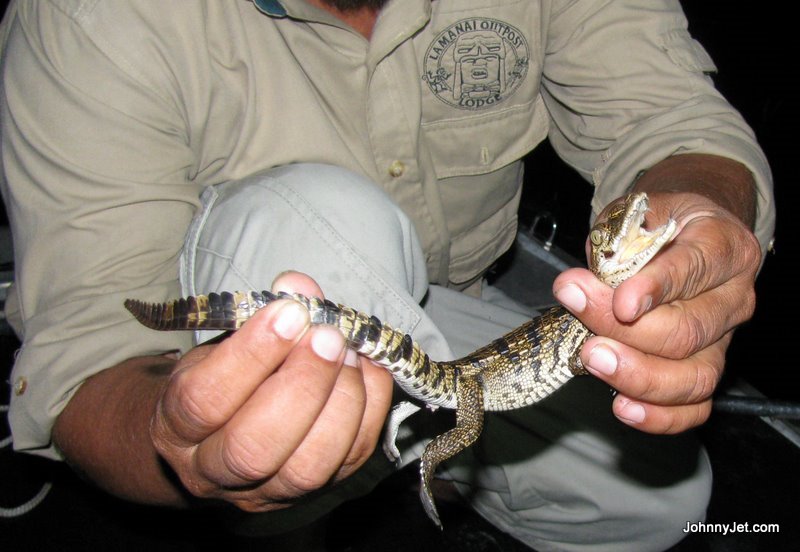 Crocodile Encounter
Crocodile Encounter
The one extra activity at the Outpost Lodge is the croc encounter, which costs $50 USD per person. Ruben and his colleague George are the guides and you go out after dinner in a loud airboat. It’s pitch black and you cruise through weeds and open water. The place was recently flooded so it looked like something from outer space. Ruben pans the area with a search light and I have no idea how they can spot the crocs because I mistook countless lily pads and their flowers for the croc’s red eyes but these guys are professionals.
For the smaller crocs, they just grab them with their bare hands. The big ones can be up to 10 feet long and take a couple hours to get into the boat. Our whole trip took just under two hours and most of that time was recording the croc data on one of the two crocs we (and by we, I mean George) caught. The lodge assists the University of Florida in monitoring these endangered species. What’s amazing is that the one we brought up already had a microchip planted in it (the only way to tell is by scanning it with an instrument) so they didn’t need to pop one in, which, by the way, doesn’t bother the crocs at all. When George was holding the croc, I thought he was twisting it but it turns out that crocs do a death roll when they get captured or when they get their prey. One did it to me as I was holding her and she was so strong. I can’t imagine what the big ones must feel like.
Time to Go
When it was time to pack up and leave I was actually wishing we had another night or two, which was surprising because when I first arrived I was thinking two days is going to be way too long. But being out in the middle of nowhere in clean comfortable digs, with good food, fantastic guides and ruins is really something magical. I think I learned at least a tiny bit about how to live in the jungle.

